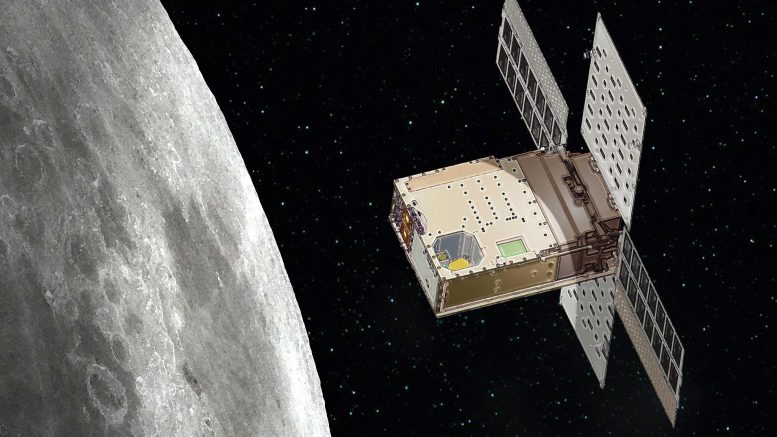
This illustration shows NASA’s Lunar Flashlight over the Moon. NASA’s Lunar Flashlight mission, launched in December 2022 with the objective of locating surface ice on the Moon’s South Pole, has been ended due to the inability of its miniaturized propulsion system to generate sufficient thrust to achieve lunar orbit. Despite this setback, several technology demonstrations on the mission, including the propulsion system, green fuel, Sphinx flight computer, and upgraded Iris radio, exceeded expectations, providing valuable insights for future missions. Credit: NASA
While the CubeSat couldn’t reach the lunar South Pole to help seek ice, it fulfilled several technology goals that will empower future missions for the benefit of humanity.
NASA has ended its Lunar Flashlight mission, launched in 2022, due to insufficient thrust from its miniaturized propulsion system. Despite failing to achieve its goal of detecting lunar surface ice, the mission yielded valuable data from new technologies, with several components exceeding expectations. Currently, the satellite is returning towards Earth, with its future under consideration by NASA.
NASA’s Lunar Flashlight launched on December 11, 2022, to demonstrate several new technologies, with an ultimate goal to seek out surface ice in the permanently shadowed craters of the Moon’s South Pole. Since then, the briefcase-size satellite’s miniaturized propulsion system – the first of its kind ever flown – proved unable to generate enough thrust to get into lunar orbit, despite months of effort by the operations team. Because the CubeSat cannot complete maneuvers to stay in the Earth-Moon system, NASA has called an end to the mission.
NASA relies on technology demonstrations to fill specific knowledge gaps and to test new technologies. Used for the first time beyond Earth’s orbit, Lunar Flashlight’s propulsion system and green fuel were such demonstrations. Although the propulsion system was unable to produce the desired thrust – likely because of debris buildup in the thruster fuel lines – newly developed propulsion system components exceeded performance expectations.
Also surpassing expectations were Lunar Flashlight’s never-before-flown Sphinx flight computer – a low-power computer developed by NASA’s Jet Propulsion Laboratory in Southern California to withstand the radiation of deep space – and the spacecraft’s upgraded Iris radio. Featuring a new precision navigation capability, the radio can be used by future small spacecraft to rendezvous and land on solar system bodies.
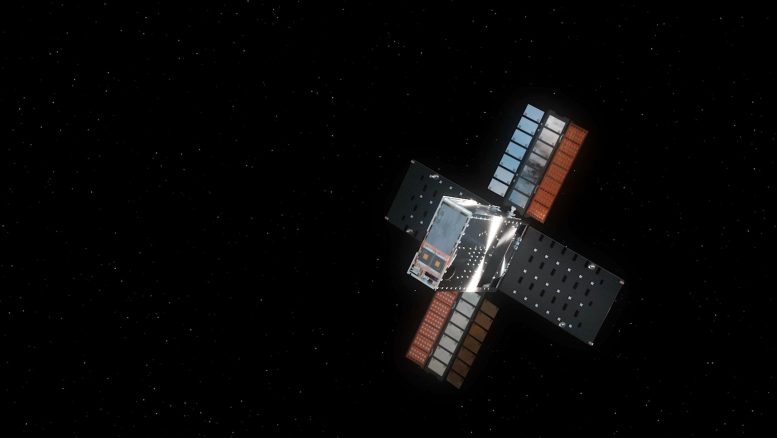
This illustration shows NASA’s Lunar Flashlight, with its four solar arrays deployed, shortly after launch. The small satellite, or SmallSat, will take about three months to reach its science orbit to seek out surface water ice in the darkest craters of the Moon’s South Pole. Credit: NASA/JPL-Caltech
“Technology demonstrations are, by their nature, higher risk and high reward, and they’re essential for NASA to test and learn,” said Christopher Baker, program executive for Small Spacecraft Technology in the Space Technology Mission Directorate at NASA Headquarters in Washington. “Lunar Flashlight was highly successful from the standpoint of being a testbed for new systems that had never flown in space before. Those systems, and the lessons Lunar Flashlight taught us, will be used for future missions.”
The mission’s miniaturized four-laser reflectometer, a science instrument that had never flown before, either, also tested successfully, giving the mission’s science team confidence that the laser would have been able to detect ice if it were present at the lunar surface.
“It’s disappointing for the science team, and for the whole Lunar Flashlight team, that we won’t be able to use our laser reflectometer to make measurements at the Moon,” said Barbara Cohen, the mission’s principal investigator at NASA’s Goddard Space Flight Center in Greenbelt, Maryland. “But like all the other systems, we collected a lot of in-flight performance data on the instrument that will be incredibly valuable to future iterations of this technique.”
Propulsion System Performance Challenges
Despite the mission’s technological wins, Lunar Flashlight’s miniaturized propulsion system struggled to provide sufficient thrust to put the CubeSat on course for the planned near-rectilinear halo orbit that would have given the spacecraft weekly flybys of the Moon’s South Pole.
The team suspects that debris obstructed the fuel lines, causing the diminished and inconsistent thrust. The miniaturized propulsion system included an additively manufactured fuel feed system that likely developed the debris – such as metal powder or shavings – and obstructed fuel flow to the thrusters, limiting their performance. Although the team devised a creative method for using just one thruster to maneuver the spacecraft, Lunar Flashlight needed more consistent thrust to reach its planned orbit.
The operations team calculated a new orbit that could be reached using the spacecraft’s small amount of potential remaining thrust. The plan called for putting the CubeSat on a path that would place it in orbit around Earth rather than the Moon, with monthly flybys of the lunar South Pole. While this would have meant fewer flybys, the spacecraft would have flown closer to the surface.
With the mission running out of time to arrive at the needed orbit, the operations team tried to dislodge any debris from the fuel lines by increasing the fuel pressure well beyond the propulsion system’s designed capacity. Despite limited success, the required trajectory correction maneuvers couldn’t be completed in time.
“The student operations team at Georgia Tech, with assistance from JPL and NASA’s Marshall Space Flight Center, rose to the challenge and came up with an incredible array of inventive techniques to utilize what tiny amount of thrust Lunar Flashlight’s propulsion system could deliver,” said John Baker, Lunar Flashlight project manager at JPL. “We learned a lot and honed new methods and strategies for working with tiny spacecraft.”
After having traveled out past the Moon, Lunar Flashlight is now moving back toward Earth and will fly past our planet with a close approach of about 40,000 miles (65,000 kilometers) on May 17. The CubeSat will then continue into deep space and orbit the Sun. It continues to communicate with mission operators, and NASA is weighing options for the future of the spacecraft.
More About the Mission
Lunar Flashlight is managed for NASA by JPL, a division of Caltech in Pasadena, California. The CubeSat is operated by Georgia Tech, including graduate and undergraduate students. The Lunar Flashlight science team is led by NASA Goddard and includes team members from the University of California, Los Angeles; Johns Hopkins University Applied Physics Laboratory; and the University of Colorado.
The CubeSat’s propulsion system was developed by NASA Marshall in Huntsville, Alabama, with development and integration support from Georgia Tech. NASA’s Small Business Innovation Research program funded component development from small businesses including Plasma Processes Inc. (Rubicon) for thruster development, Flight Works for pump development, and Beehive Industries (formerly Volunteer Aerospace) for specific 3D-printed components. The Air Force Research Laboratory also contributed financially to the development of Lunar Flashlight’s propulsion system. Lunar Flashlight is funded by the Small Spacecraft Technology program based at NASA’s Ames Research Center in Silicon Valley and within NASA’s Space Technology Mission Directorate.

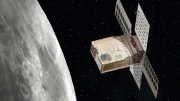

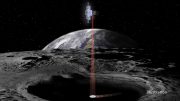
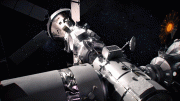

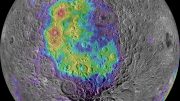
Congratulations to NASA on their flash of success in this spectacular failure; they learned components did better than expected failing, and got the data that their new technology fails. But NASA taught us that nothing is a failure if you continue the mission and learn the lessons. The new AF-M315E “Green Fuel” invented galactic range anxiety, despite being in no conceivable way ‘green’ or environmentally friendly apart from “AF-M315E has significantly reduced toxicity levels compared to hydrazine” (nasa.gov) — oh good, significance! Now they can’t track polar ice levels on the moon, so they’ll have to leave out lunar climate change in their constant stream of climate nagging. Speaking of which, NASA, what was the carbon footprint of this spectacular lunar project you’ve now flung at the Sun? Try taking shorter meteor showers. In the meantime, don’t send people to the Moon for no reason using fake ‘green’ anything like this, or you’ll set space exploration back decades.